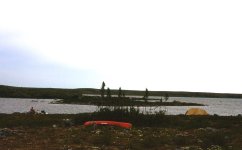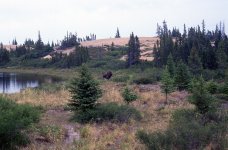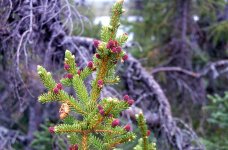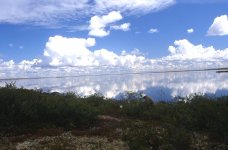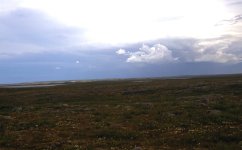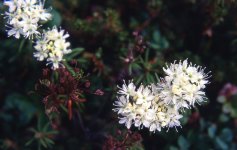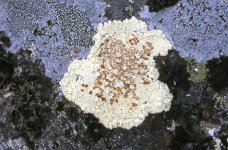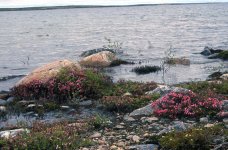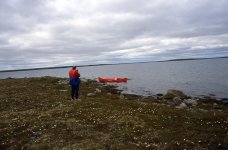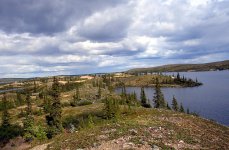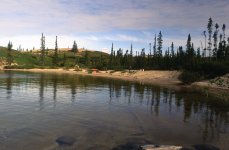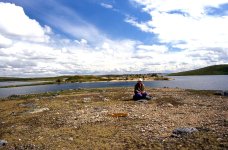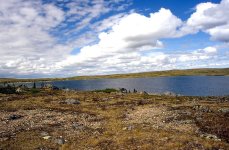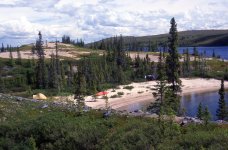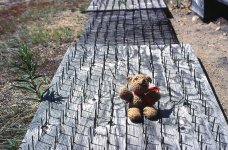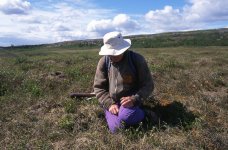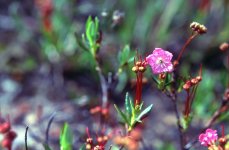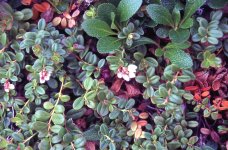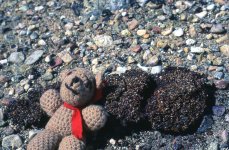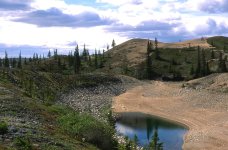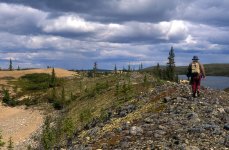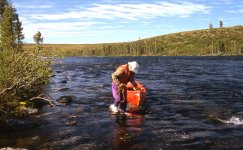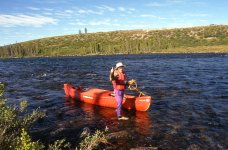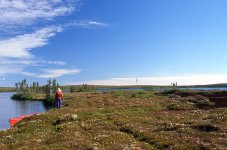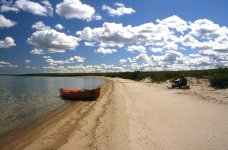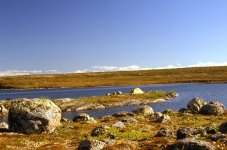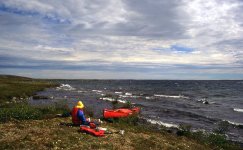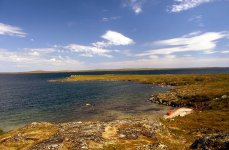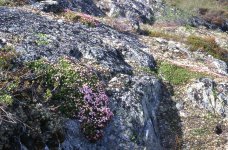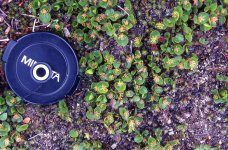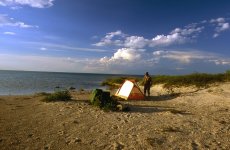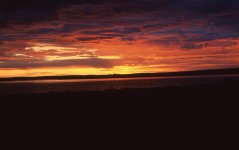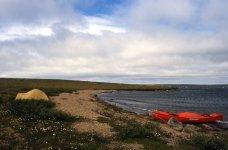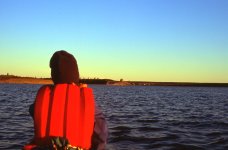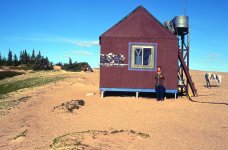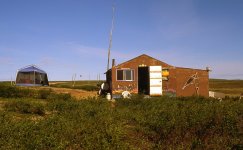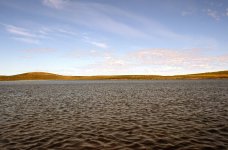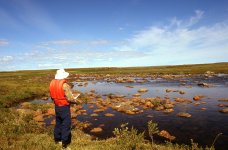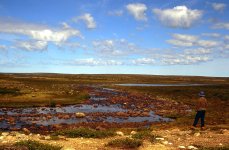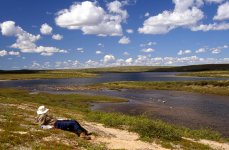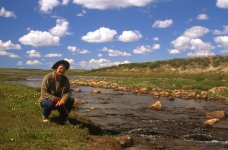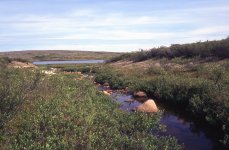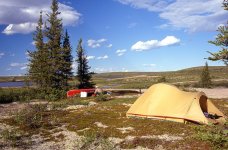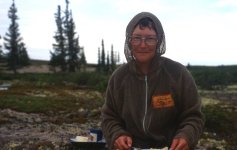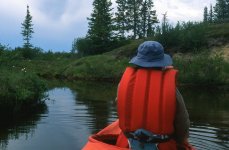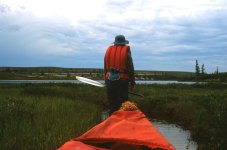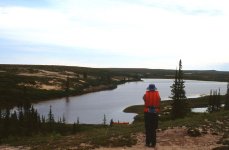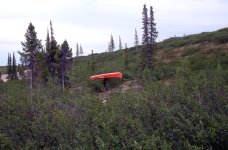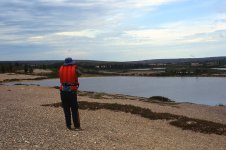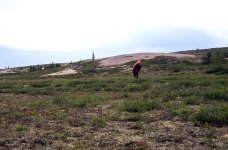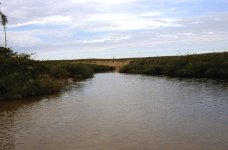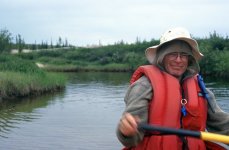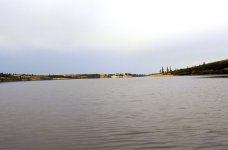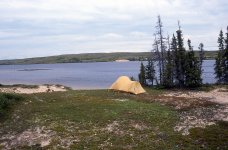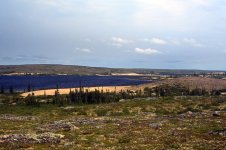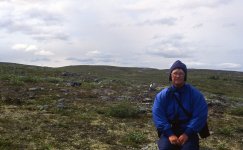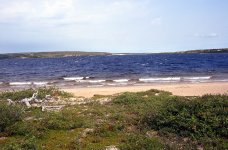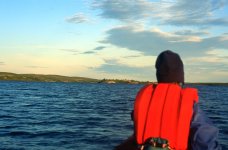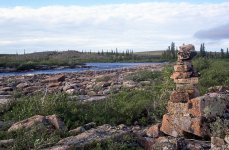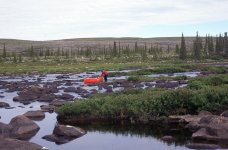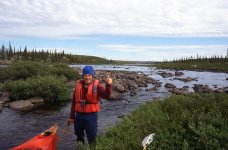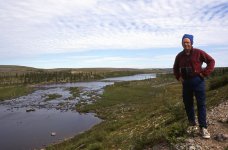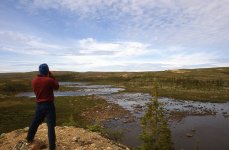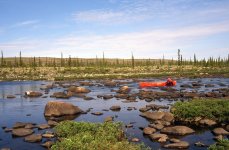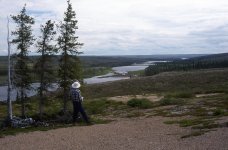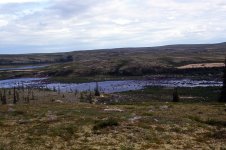- Joined
- Aug 21, 2018
- Messages
- 1,805
- Reaction score
- 4,494

Kathleen and I chose to paddle the Snowdrift River for four reasons. First, we could land at the same spot at which we began our Thelon River trip in 1993, which very much appealed to us. We loved that camping spot at the east end of Lynx Lake. Secondly, instead of travelling east toward Hudson Bay, we could paddle west toward Great Slave Lake. Starting at the same spot but ending up in completely different watersheds intrigued us. Thirdly, during the first part of the trip, we would be living on the tundra and camping on eskers, one of our favourite landscapes. And finally, during the last portion of the journey, we would enjoy the transition back to the boreal forest. There was also the strong possibility of finding Tundra Tom's ecotourism camp at the west end of Whitefish Lake. If so, that might provide a pleasant interlude.
The only information that we could find on the Snowdrift River was a six-page summary prepared by Ed Struzik as part of the series of Northwest Territories River Profiles. Ed found the “upper reaches of the headwaters too shallow for canoe navigation,” with water levels “less than a foot (30 cm) deep for long stretches. There were also a lot of rapids and rock gardens below Sandy Lake.” As a result, Ed’s group began their trip “on a small lake about 15 km (9 miles) below Sandy Lake.”
This didn’t concern us (or should I say me) too much. Kathleen and I are used to shallow, rocky rapids. And a portage or two is just part of every wilderness canoe trip. Besides, our trip would begin at Lynx Lake. We had no choice. We had to go through Sandy Lake and the shallow, turbulent water below.
The Snowdrift River ends its journey at Great Slave Lake, near the small community of Lutseltk’e, which until 1992 was known as Snowdrift. Ideally, Kathleen and I would have paddled all the way to Lutseltk’e. Ed’s summary, though, noted that the last 50 km (30 miles) of the Snowdrift River below Austin Lake contained “approximately 35 rapids and waterfalls, most of (which) require portaging.” I kind of like portaging, but like Ed, we decided to end our trip at Austin Lake.

Sandy Lake was approximately 134 km (83 miles) and 11 days into our trip. We had allowed 2 days to complete the 10-km (6 miles) stretch of four rapids below Sandy Lake that are marked on our topographic map. Ed reported that another rapid marked on our map, about 4-5 days below Sandy Lake, is actually a waterfall, and is a must portage.
I had allocated 26 days to paddle 330 km (205 miles) between Lynx Lake and Austin Lake. This would give us plenty of time to do the Snowdrift River comfortably. As I told Kathleen, “We have to average only 12 km/day (7.5 miles) to complete the trip.”
By comparison, Kathleen and I did the Thelon's 950 km (590 miles) in 37 days, for an average of 25.7 km/day (16 miles). This included nearly 200 km (124 miles) of tundra lakes and 7 portages, one of which was 5.5 km (3.4 miles) long. Carey, Janice, Kathleen, and I did the Coppermine's 645 km (400 miles) in 29 days, for an average of 22.3 km/day (13.8 miles). This included 4 days on a large tundra lake, 15 portages totalling 9.6 km (5.9 miles), 13 drags totalling 5.8 km (3.6 miles), and 4 trackings upstream totalling 1.7 km (1 mile). We did 283 km (175 miles) on the Seal River in 15 days, for an average of 18.9 km/day (11.7 miles). That included a couple of portages and some scouting of the 39 rapids, 16 of which were rated Class III or IV.
Of course, starting and ending our Snowdrift River trip in two completely different watersheds meant that Kathleen and I would have to cross over the height of land. Six years had passed since our struggles on the Coppermine River, and Kathleen had apparently forgotten about the potential rigours of dragging, portaging, tracking, lining, and occasionally paddling our canoe over a continental divide.
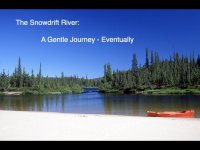
Even so, I genuinely believed the Snowdrift River would be the most gentle wilderness canoe trip we had ever attempted. As I told Kathleen, “There is only one rapid out of Whitefish Lake, and only a few rapids below Sandy Lake. We’ve never had a trip so easy. In fact, this will be the easiest canoe trip that we have ever done!”
I don’t know why I say those things. I just do. And I don’t know why Kathleen continues to believe me. She just does. I was confident, though, that the Snowdrift River would be easy. Only 12 km/day (7.5 miles). That’s doable, even if we portaged and dragged much of the way. I’m not saying that I would want to portage and drag much of the way. I’m just saying that it would be possible.
And certainly we wouldn’t have to portage and drag very much of the way. Most of the first 114 km (71 miles) would be on Lynx and Whitefish Lakes. No portaging or dragging required on these lakes. From the west end of Whitefish Lake, it was only 20 km (12 miles) to Sandy Lake, just beyond the continental divide. I had allocated 12 days to reach the west end of Sandy Lake and its outlet to the Snowdrift River. Only 12 days from Lynx Lake and we would be lazily drifting the final 200 km (124 miles) down to Austin Lake. This would, without doubt, certainly be the easiest trip we had ever done. Just Kathleen and me. Alone on the river. Floating easily through the wilderness. A perfect canoe trip.
I don’t remember if I really stressed to Kathleen the information in Ed Struzik’s brief Snowdrift River report that described the “upper reaches of the (Snowdrift) headwaters (below Sandy Lake as) too shallow for canoe navigation.” Maybe Ed was wrong, After all, he hadn’t actually paddled that stretch of river below Sandy Lake. I’m not just being naively optimistic here. Kathleen and I have a fair amount of experience with shallow rocky rivers. We don’t need much water to float our canoe. We’d be content with as much as 30 cm (1 ft).
Anyway, from the west end of Whitefish Lake, where we would begin our journey over the height of land, the tentative itinerary indicates that we would need to average only 14 km/day (8.5 miles) to reach Austin Lake in time for our pre-arranged pickup by float plane. And, if we had to, we could portage the entire 10 km (6 miles) below Sandy Lake. At three loads each, it would be a total distance of only 50 km (30 miles) . It would be like a moderate, 3-day backpacking trip. And half of that distance would just be sauntering back to pick up another load. After completing the portage, we could make up time and distance quickly by putting in long days on the flowing Snowdrift River. Piece of cake. Anyway, I never believed that we would need to portage the entire 10-km (6 miles) stretch.
July 1. We drove into the Queen Elizabeth Campground in Fort Smith, where we spent the evening talking canoeing and Canadian exploration history with a German couple from Leipzig. They had just paddled 600 km (372 miles) in 20 days, beginning on the Clearwater River in Saskatchewan. Four of those days included the 20-km (12 miles) Methye Portage, which connected the Hudson Bay watershed with the Mackenzie River drainage system. They were following journals and reports of the Fur Brigade Trail dating back to Alexander Mackenzie. They planned to continue down the Slave River to access Great Slave Lake, and then down the Mackenzie River to Inuvik. Two East Germans, young and adventurous, living more Canadian history and geography than most Canadians are even aware exists.
The next morning we felt some anxiety as we stood on the float plane dock. It was a morning of transition. We were about to embark on another adventure of unknown stories. Another adventure out onto the Barren Grounds, our favourite landscape. At the last moment, on a whim, we packed the rest of our highway food (salami, pepperoni, cheese, cookies, apples and oranges) into the plane. We lifted off Four-Mile Lake into a northwest wind of 15 knots. Two hundred and eighty-eight pounds (131 kg) of gear, plus the canoe tied onto the left pontoon of the Cessna 185.
Ninety minutes later, we landed at Manchester Lake to refuel from fuel drums that had been cached there. The wind had increased to 25 knots, and our pilot Gary now looked a bit worried. I didn’t know why, but Gary explained.
“The lake might not be long enough to take off into this wind. If we don’t lift off by the time we come even with that point down there, I’ll have to shut ’er down. Then we can float through the channel to the next lake and see if that lake is long enough to take off into the wind.”
Apparently Gary really was worried. Even so, we lifted off easily just before reaching the point and continued east for 45 minutes to where we looked down on Lynx Lake.
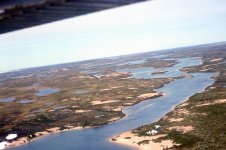
This is what the outlet to the Thelon River from the east end of Lynx Lake in 1993. This time though, the outlet bay to the Thelon River seethed in crashing waves, and breakers rolled across the lake’s surface, running before the wind.
Gary’s voice cracked through the head set: “We gotta get out of here, and look for somewhere else to land. The wind is at 55 knots!”
For those of you who don’t know, a knot is equal to one nautical mile, or 1.151 miles/hour (1.852 km/hour). This puts the wind blowing toward us from the northwest at 63.3 miles/hour (101.9 km/hour). I didn’t know those conversions myself until I looked them up just now, nearly 13 years later. I think Gary knew all along what 55 knots meant, as he now looked very worried. I don’t know how much wind a Cessna 185 can tolerate, but as Gary said, “We gotta get out of here!”
And out of there we got. We banked left, to the port side, and swung back towards the west. We flew in silence, our bodies tense, as the plane tossed and heaved against the wind. We stared downward, looking for safety. You might ask, “Just where do you think you’re actually going to find safety? Isn’t it windy everywhere? Isn’t it windy all the way back to Fort Smith?”
I’m glad you weren’t there to ask those questions. You would have been right, of course. Realizing that, I might have been more worried. As it was, I still wasn’t too worried. Things always seem to work out for me.
Gary announced his plan through the head set. “We have to find calmer water in the lee of an island, any island big enough to break the wind even just a little. Then we just might be able to land.”
Sounded like a good plan to me. I certainly didn’t have any better plan. Only problem was, though, there didn’t seem to be a lot of big islands in sight. Actually, there weren’t any big islands in sight. Just low, small pieces of land surrounded by crashing waves. I now began to worry. I looked at Gary, whose face showed resolve. We flew and searched, and I truly began to appreciate the old phrase, “Any port in a storm.”
“I’m gonna try to take the plane down here,” Gary said. “The waves look a bit smaller by that island.”
We began our slow descent. “Oh my, oh my,” Gary said. “Those swells must be four feet (120 cm).” Kathleen and I didn’t say anything. Gary was in charge. Our fate was in his hands. I trusted him.
Suddenly we pulled out of our descent and rose again, and circled around. Gary said, “I gotta check for rocks. We don’t want to hit any rocks.”
Again, a good plan. We circled around until Gary was satisfied that there were no rocks blocking our intended path to the shore. We began our descent for the second time.
“Oh my, oh my, those swells must be eight feet (240 cm).”
I’m not making this up. That’s what Gary said. I expected that we would now lift up again, like before, and look for somewhere else to land. Eight-foot swells certainly sounded worse than 4-ft. swells. In fact, they sounded twice as bad. Gary might have been exaggerating during the excitement of our predicament, but the breaking waves did look darn big.
But no, we continued slowly downward. Float planes are supposed to land softly on the water. That’s what pontoons are for. On previous canoe trips, we had landed softly every time. This time, though, we hit the water very hard and bounced back up into the air, like a stone skipping across the water. We hit the water again, and bounced a second time. Again, we hit the water, and bounced a third time. The Cessna 185 now veered sharply to port side, and Gary gunned the throttle. This time, when we hit the water, we didn’t bounce but rammed forward onto a beach at the foot of an esker, maybe 3 m high. Gary turned to me, reached across the cockpit, shook my hand, and said, “Boy, am I glad to be on the ground.”
“You know, Gary, I thought the waves were worse the second time we started to descend. I thought you were going to pull up.”
“I wanted to, but we had already lost too much speed. We were committed to whatever was going to happen.” I’m glad Gary didn’t tell me that at the time.
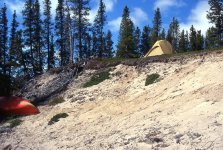
We set up camp at 5:00 p.m. as the wind intensified even more. We fed our highway food, two gorp snacks and some of our supper soup to Gary, who had brought no supplies with him, not even a jacket. “If I can’t fly out of here by 10:00 this evening, I’ll have to stay overnight.”
We loaned Gary one of our sleeping bags while he rested, waited, and shivered in the cockpit. I guess he felt more comfortable in his plane than by our fire. At 9:45 the wind slackened and Gary escaped to the southwest, leaving only a few minutes before it became too dark to fly legally.
We were now alone, as we wanted to be, but we felt a little bit uneasy. We didn’t really know where we were, although Gary and I both independently picked the same small island on the map. I don’t know why I didn’t just ask Gary to refer to his GPS on the plane. Kathleen and I carry only maps and compass, which are useful only if you know approximately where you are. What had we done? The myriad of bays, channels, and low islands would be quite difficult to navigate if we were very wrong about our location.
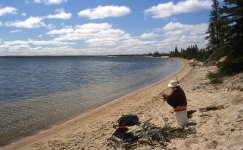
July 3. We slept late and woke to a calm morning. Best of all, there were almost no bugs. We enjoyed a slow, relaxing morning of bannock. During breakfast, I studied the shoreline west of our camp. According to the map, the island I believed we were on showed a sharp bend to the north around an obvious point. This shoreline, however, seemed to extend more or less straight, with only a slight curve to the north.
We strolled west down the beach and soon confirmed that there was no sharp point bending north. Just a small bay nestled into the shore, which then continued stretching west. We were definitely not where we thought we were. This was bad news. We climbed to the top of a beautiful east/west trending esker that extended for 4–5 km (2.5-3 miles). Where could we be? We studied the map, which indicated that only one long esker existed in the immediate area. So, we must be on that esker. If so, we were on a peninsula of the mainland and were only a few kilometres west of the island that we thought we were on last night. Not so bad.
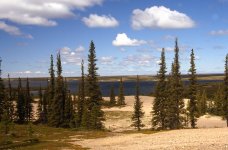
We hiked across to the north side of the peninsula, checking landmarks, curves, and bays in all four directions. We became pretty confident that we knew where we were, a very comforting feeling. I wasn’t absolutely, completely certain, though. The landscape was low and flat, and many islands and narrow peninsulas share similar physical features. And it was possible that we were just trying to make ourselves feel better by claiming to know where we were. After all, last night we also “knew” where we were.
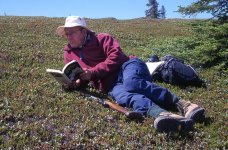
Nevertheless, we enjoyed the rest of the afternoon strolling across the tundra to greet old botanical friends: Alpine-Azalea, Bog Laurel, Bog Rosemary, Prickly Saxifrage, and Labrador Tea. We lay down and immersed ourselves in a close-up view of the tundra’s floral elegance.
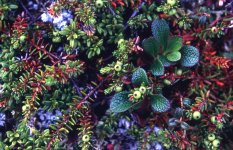
A Lapland Longspur burst out of a beautiful carpet of Red Bearberry and Crowberry that spread downhill below our feet. Crowberry, the only member of its botanical family, produces a profusion of black berries eaten by birds, voles, lemmings, and bears. Crowberry also makes fantastic kindling for starting campfires. This trailing, ground-hugging plant often grows near the water’s edge and is commonly crushed by ice thrust up onto the shore by high water and strong winds during spring breakup. It’s fragile, reddened, dead stems and leaves become tinder dry and burst into flames at the touch of a match.
After hiking north, east, and south on the peninsula for about 10 km (6 miles), we arrived back at camp, tired but satisfied. We were now even more convinced that we knew where we were. I felt immensely happy. I love this Barren Grounds landscape—its openness, its emptiness, its vistas, its freedom, and its fragrances, especially that of Labrador Tea. We dozed on the beach in the afternoon warmth. Still almost no bugs. Lynx Lake lapped gently against the shore. Tomorrow we would paddle.
July 4. Our 20th wedding anniversary. Kathleen surprised me with a very cute “Bunnies in Love” card. I laughed right out loud when I saw it. It was so darn cute! Did I give Kathleen anything? I don’t remember. Nothing was written in my journal about any gifts. Anyway, there was no time for romance. We had paddling to do. We were already one day and several kilometres behind schedule.
We put on the water at 10:15. So beautiful to paddle through the Barren Grounds. Quiet and inviting. A mosaic of water, tundra, sand and eskers. We paddled 10 km through a maze of islands to reach the north shore of Lynx Lake. We then turned west, closely studying landmarks. I checked our map and compass frequently.
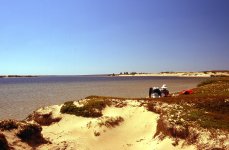
At lunch we hiked over a low ridge to confirm that a small river drained into Lynx Lake at this point. We were becoming positive that we knew for certain where we were on the map.
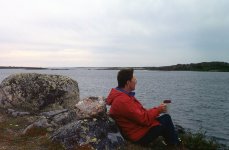
We stopped at 4:30 on a 2-m ridge of Red Bearberry growing in the cracks of the hard Canadian Shield. Bog Laurel proliferated along the shore. We camped in a narrow channel studded with islands. This further confirmed our location, as only one such channel was indicated on our 1:250,000 topographic map. It was time to stop worrying about where we were.
A diving Red-breasted Merganser entertained us during supper, which we prepared using our small Coleman backpacking stove, as no wood was available. We had 10 more days of fuel, which I hoped was enough for the 12 days that I estimated it would take us to reach more or less consistent stands of trees west of Whitefish Lake. What, you say? Ten days of fuel for 12 days to reach trees? Well, we’re bound to find little bits of wood along the way. No need to carry more fuel than necessary.
In celebration of our anniversary, we enjoyed fruitcake for dessert, followed by a bedtime brandy. A heavy haze crept into the evening sky as the wind shifted to the southwest, bringing in smoke from the many fires reported to be burning in northern Saskatchewan and Manitoba. Unfortunately, the wind was picking up again, which makes paddling impossible.
As we lay in the tent that evening, we reflected on our paddling day, during which we saw one caribou, and many small groups of flightless Canada Geese noisily running along the shore, away from our approaching canoe. Early in the paddling day, we had likely passed within 2 km (1.2 miles) of the outlet to the Thelon River, which had been our planned starting point for this trip. The outlet remained obscured, however, behind low ridges. It would have been nice to visit our camp of 1993, but 2 km was close enough. Close enough to say that we had begun this trip at the same place as our 1993 Thelon River trip. Instead of heading east to Hudson Bay, however, we were now heading west, over the height of land, to reach the Mackenzie River drainage system. danged exciting.

